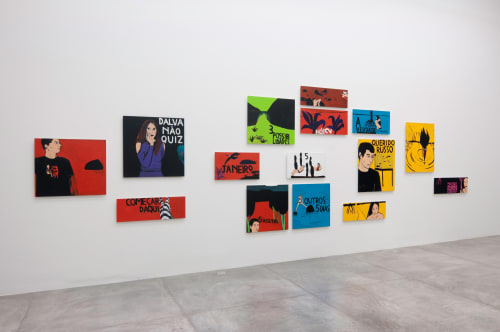Vânia Mignone: Casa Triângulo, São Paulo, Brazil
BETWEEN IMAGES
Vânia Mignone’s work evinces a development very dear to the history of contemporary art: the autonomy of drawing – no longer just scribblings, a rough sketch as a plan for something else, or a “smaller” work – and the extent to much drawing has invaded other areas, being repositioned and incorporated into a very particular state, with striking speed and boldness. Her works possess the velocity of a comic strip, a sign or billboard. They are quick lines, smudged to just the right degree, constantly evading a literal reading. We do not necessarily understand her pictures and, moreover, the text does not always fit the image. The uneasiness they provoke quickly disassociates these works from what we could call “a pop and urban atmosphere.” Her figures are sometimes solitary; at other moments, we behave as voyeurs invading a household environment uninvited, though in still other cases, with this same atmosphere, the characters do not seem the least concerned about this intrusion. It is astonishing how with such few lines and in such a relatively small space the work captivates our attention. Whether because of the characters’ eyes or in the (vain) attempt to understand that landscape. Her work pushes us into a zone that is difficult to locate. I would say that it is somewhere between silence and the (wide) interval between waiting and forgetting. A territory filled by signs that something has just taken place there, or one that has for a long time been filled only by memories. They are imprecise situations insofar as they are images of everywhere and nowhere at the same time.
Contrary to a certain “contemporary repertoire of painting,” Mignone does not choose spectacularization or an appearance of the image with an intense and full impact, but rather reveals to us a work that is swimming against the current. I say this because her images often involve banal actions (a girl listening to music on her headphones, a bird on the lake, or a man observing the horizon), but which do not in any way banalize the image. This reasoning explains the choice of the title of this essay, that is, the degree to which the image constructed by the artist transcends the support of bi-dimensionality and evokes an image in transit or a work that can be articulated with other image-producing instances, most notably cinema.
Her works can correspond to the frames of a film, but we simultaneously perceive that they can only belong to a certain cinematographic quality as, for example, that of a film by David Lynch, in which the breaking of a formal narrative and the experience of time are re-elaborated at every moment. This negotiation also takes place in Mignone’s work: initially, the references can arise easily, but they do not necessarily remain for long, because they soon become blended. Her artworks question us in regard to what place or landscape we are seeing. There is a sort of mystery to be deciphered.
Felipe Scovino


